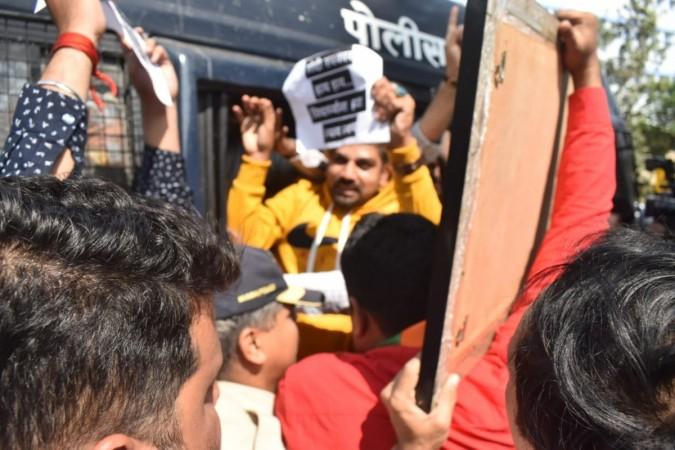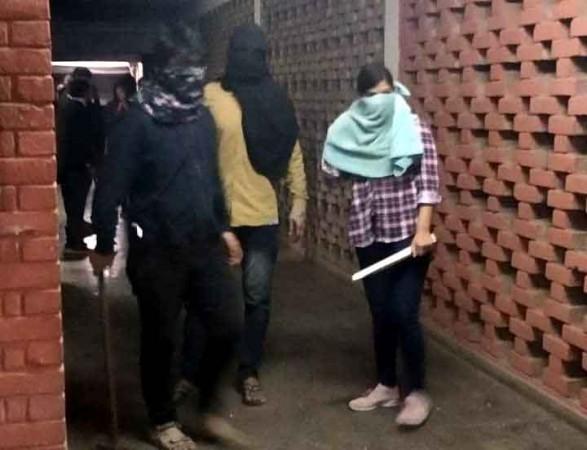The protestors and activists gathered at the Gateway of India in Mumbai, to condemn the attacks in the JNU campus late on Sunday, were cleared by the police and shunted to Azad Maidan on Tuesday.
Deputy Commissioner of Police (Zone I) Sangram Singh Nishandar led a police team to the Gateway of India and requested the protestors, who occupied the area since Sunday midnight to vacate and go to the Azad Maidan, around 2 km away, but they refused to comply.
"The protest here is causing inconvenience to the people, office-going commuters, tourists... Plus, there are no water and toilet facilities here. So we have 'relocated' them to Azad Maidan which is better equipped for such mass gatherings," DCP Nishandar told the media.

There are indications that the police may book the protestors for trespassing at the venue without police permission which is also a landmark tourist attraction, opposite the Hotel Taj Mahal, and the jetties from where people bound for Elephanta Island or mainland locations like Raigad and Ratnagiri, etc can board ferries, motor-boats, catamarans, etc.
How were the protests organised?
The protests in Mumbai started in a small way around midnight (Sunday-Monday), through messages relayed on social media networks with candle-lit vigils and a procession to the iconic Gateway of India.
By the afternoon of Monday, the trickle swelled into huge crowds at the Gateway of India, with many protestors apparently prepared for a long vigil on Monday night.
Many of them carried stocks of snacks and water, mobile chargers and battery banks, basic medicines, blankets/shawls to beat the chill, even tampons and napkins.

Local eateries chipped in their support by throwing open their toilets for the protestors and even made arrangements for food and water for them as per their requirements.
Present at the Gateway of India on Monday were several politicians and celebrities like Sushant Singh, Varun Grover, Shrikant Matondkar, legislators Abu Asim Azmi, Rohit Pawar, Kapil Patil, farmers leader Ashok Dhawale, activists like Jatin Desai, Fahad Ahmad, NCP leader and Housing Minister Dr Jitendra Awhad, among many more, who joined the protests.
The participants included students from IIT Bombay, TISS, the University of Mumbai, several city colleges, youth and social organisations, activists and others, who trooped with hand-painted banners/posters with anti-BJP-ABVP slogans, the National Tricolour, pictures of Mahatma Gandhi, Dr BR Ambedkar and other leaders, and demanded action against the perpetrators of the violence at the JNU campus on Sunday.
What happened in JNU?
Unprecedented violence was seen in the Jawaharlal Nehru University on Sunday as a masked mob assaulted students and teachers inside the campus with wooden and metal rods, injuring many.
The injured included two office-bearers of the Jawaharlal Nehru University Students Union (JNUSU), including President Aishe Ghosh - who was reportedly hit over the eye with an iron rod, received severe injuries.

"I have been brutally beaten up by masked people. I don't know who they were," Ghosh said as she broke into tears while blood flowed profusely from her head.
JNUSU General Secretary Satish Chandra was also injured in the attack.
JNUSU Vice President Saket Moon accused the RSS-affiliated Akhil Bharatiya Vidyarthi Parishad of leading the attack, which was bolstered by outsiders.
Hostel rooms, and lobbies, and vehicles standing on the road were vandalised during the assault.
There were terrifying moments for students as the masked men and even women with faces covered, barged into hostels, ransacked rooms and beat up the frightened students.
A girl student recounted those moments in tears: "I was in the room and I heard loud noises and I saw many girls coming. I asked everyone to lock their rooms. We were in terror. While I was trying to take a video clip, they hit me with a stone."
(With agency inputs.)









!['Had denied Housefull franchise as they wanted me to wear a bikini': Tia Bajpai on turning down bold scripts [Exclusive]](https://data1.ibtimes.co.in/en/full/806605/had-denied-housefull-franchise-they-wanted-me-wear-bikini-tia-bajpai-turning-down-bold.png?w=220&h=138)



